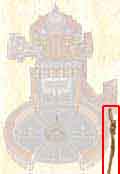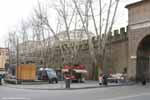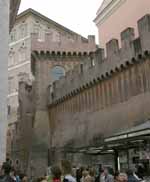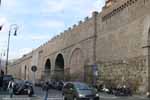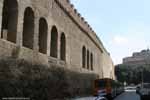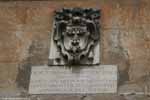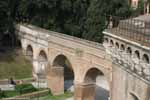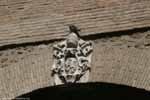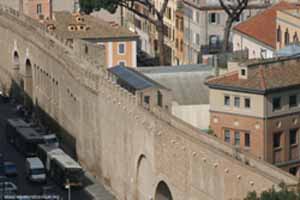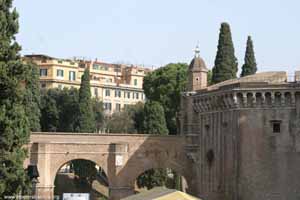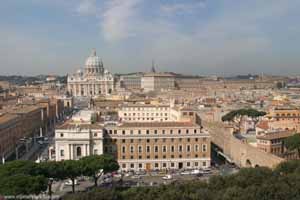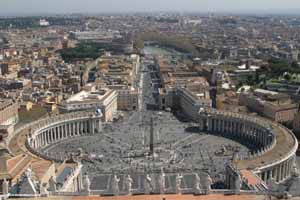| Grottoes
Vatican City Colonnade Saints Floorplan #2 |
| Altars
Monuments The History |
|
Related Items |
Related Links
Curious And
Unusual
Rome Art
Lover
Wikipedia
Angels
& Demons
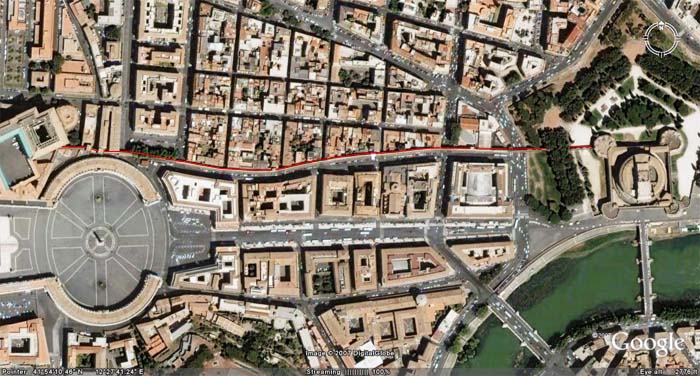
Image from Google
Earth - View Large Image 3000
x 655
The Passetto (small passage) is the corridor atop the old Vatican wall between St. Peter's and the Castel Sant' Angelo. This 800m long passageway is also known as the Passetto di Borgo (the district where it's located), or in earlier times, the Corridore di Borgo. During the Sack of Rome in 1527, it was used by Pope Clement VII to escape to the Castel Sant' Angelo.
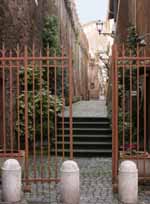 In the Borgo Passetto on Left |
|
From
'The Companion Guide to Rome' by Georgina Masson From:
'A Traveller in Rome' by H.V. Morton 'Naturally we hope that if the Holy Father ever asked for the keys, it would be for purely antiquarian reasons,' said the officer. 'And we always have them ready.' An air of incredible age hangs about odd and unfrequented places such as this. They are never cleaned up for visitors, and remain just as the centuries have left them, like an old attic full of lumber which no one visits from one generation to another. As we explored this queer, dusty bit of the Middle Ages, we came to the locked gate leading to the corridor, a place which has the attraction of a secret passage. The top is a machicolated walk and the corridor itself is a narrow, arched passage hardly wide enough for two people to walk abreast, and is roughly paved with brick and lit every few yards by windows let into the thick walls. I though of that terrible morning of May 6, 1527, when, aided by a fog that followed the sunrise, the armies of Charles V advanced to the attack on Rome. There were Lutheran Germans, Catholic Spaniards and Italians, but there was nothing to choose between them: they were all ruffian mercenaries who had been unpaid for months and thirsted for loot. As they stormed the Borgo, Clement VII, appalled by the fate his politics had brought upon Rome, was on his knees in St. Peter's. At first he was resolved to dress in full pontificals and meet the enemy seated upon his throne, as Boniface VIII had waited for Sciarra Colonna two hundred years before: but as the cut-throats broke into the Hospital of S. Spirito, slaying all the patients to spread terror, and the cries of the dying and the explosion of cannon were heard on the very steps of St. Peter's, the Pope was persuaded to take flight along the covered corridor to S. Angelo. 'Had he stayed long enough to say three creeds,' wrote an eyewitness, 'he would have been taken.' Wearing the enormous scarlet train of his cappa del papa,the distracted Pope was shown into the vaulted corridor and, to help him along, a Cardinal looped the train over his arm. Clement wept as he looked down through the windows of the passage and saw the fearful scenes in the street below and in the space before St. Peter's, where the Swiss Guard was dying to a man. The windows were so close together in the corridor that a Cardinal, afraid that the Pope might be recognized by arquebusiers from below, flung a cloak over his head and shoulders, and in that way Clement VII was smuggled into the castle.... In the corridor to S. Angelo one feels, as one does in the Tower of London, that nothing cheerful could ever have happened there. |
||||
|
|
||||
This independent website is not endorsed by or associated with the Vatican, the Fabbrica of St. Peter's, or any business organization
Contact: stpetersbasilica@gmail.com
